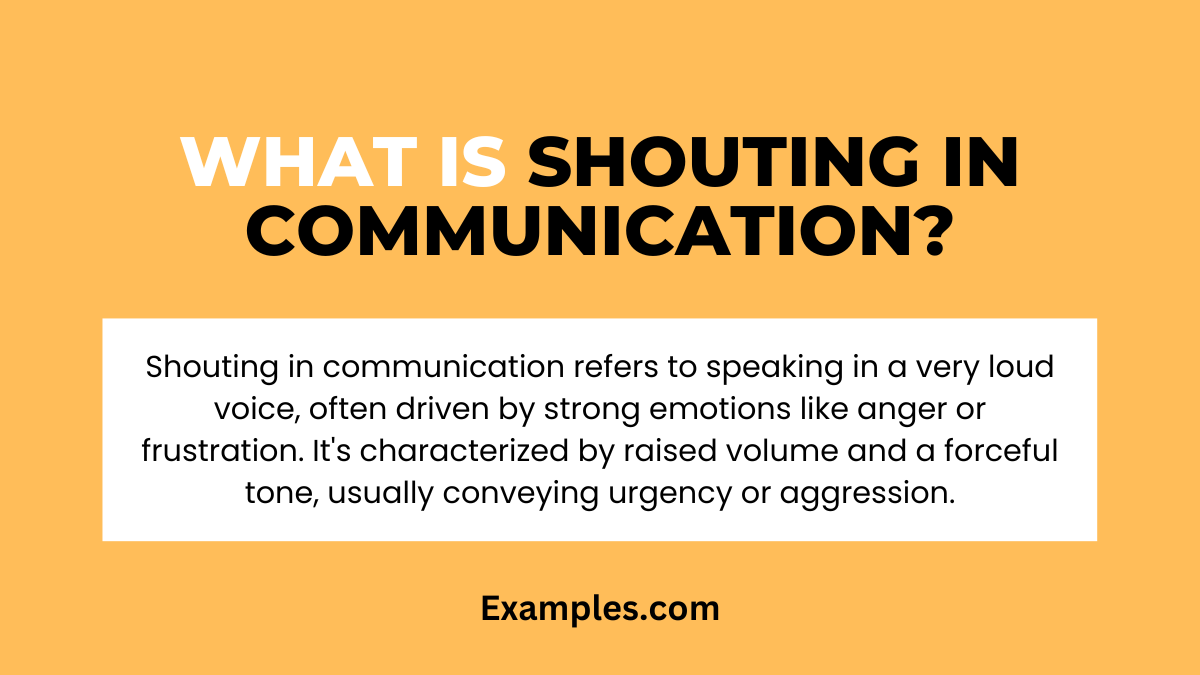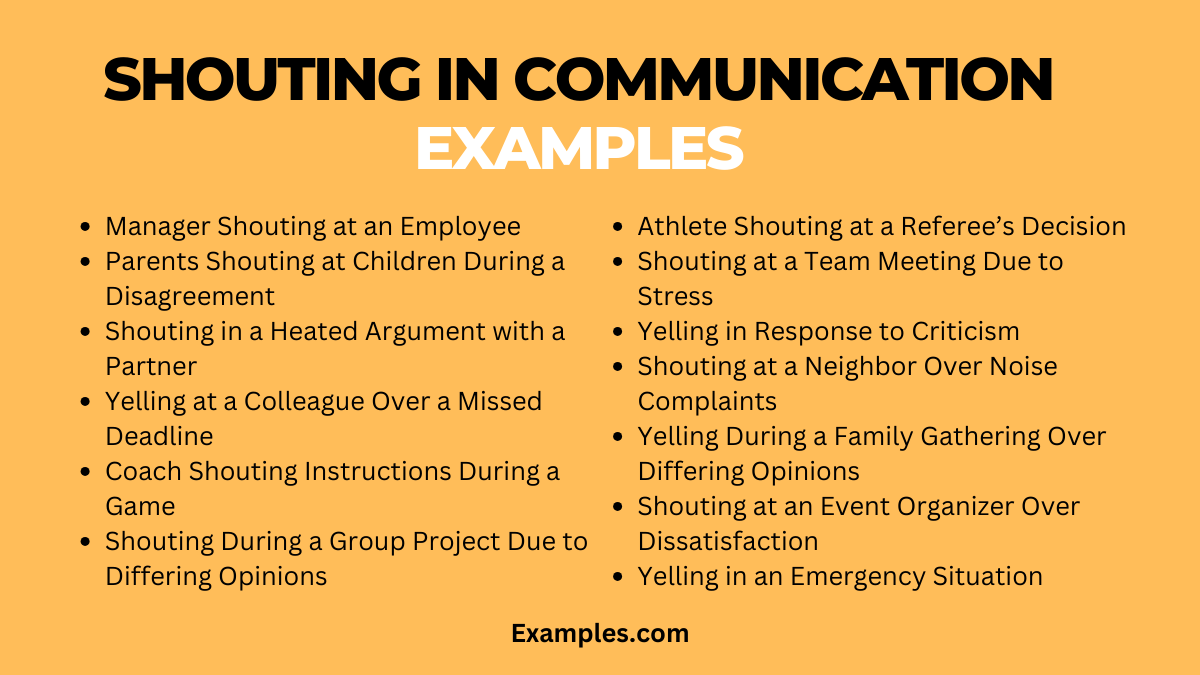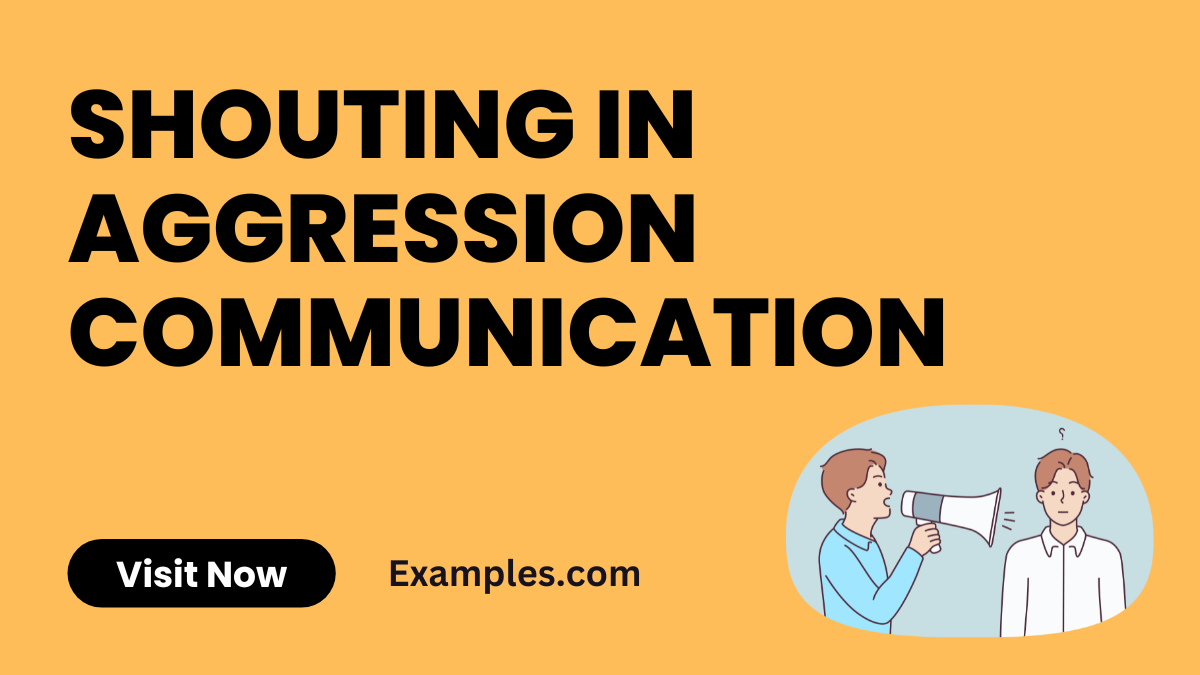19+ Shouting in Communication Examples
Discover the Impact and Nuance – This comprehensive guide delves into the complex role of shouting in various communication contexts. It explores how shouting can be both a hindrance and a tool, depending on the situation and intent. Through real-life examples, learn about the effects of shouting on listener perception, the emotional responses it can evoke, and strategies to use or counteract shouting effectively in different scenarios. This guide is essential for anyone seeking to understand the dynamics of vocal intensity in communication, from interpersonal relationships to professional environments.
What is Shouting in Communication?

Shouting in communication refers to speaking in a very loud voice, often driven by strong emotions like anger or frustration. It’s characterized by raised volume and a forceful tone, usually conveying urgency or aggression. Shouting can be used to dominate a conversation, express intense feelings, or demand attention. However, it can also lead to misunderstandings and negatively affect interpersonal relationships, as it often appears confrontational or intimidating.
20 Shouting in Communication Examples

Shouting in communication often occurs in high-stress or emotional situations and can lead to misunderstandings and conflict. It’s vital to recognize its impact on relationships, workplace dynamics, and overall communication effectiveness. This guide provides 20 examples of shouting in various contexts, exploring the consequences and offering alternative approaches for more productive conversations. Understanding these scenarios helps in developing healthier communication habits and fosters a more respectful interaction environment.
- A manager shouting at an employee during a meeting: This can create a hostile work environment, reducing morale and productivity. Instead, addressing issues calmly and privately is more effective.
- Parents shouting at children during a disagreement: This can damage the child-parent relationship. It’s better to discuss matters calmly and listen to the child’s perspective.
- Shouting in a heated argument with a partner: Escalates tension instead of resolving conflict. A more constructive approach is taking a break and revisiting the conversation calmly.
- Yelling at a colleague over a missed deadline: This can strain professional relationships. Opt for a discussion to understand the reasons behind the delay and find solutions.
- A coach shouting instructions during a game: Can be perceived as aggressive. Clear, assertive communication is more effective in guiding team members.
- Shouting during a group project due to differing opinions: Leads to a breakdown in teamwork. It’s better to encourage open dialogue and compromise.
- Yelling at a service staff in frustration: Reflects poorly on one’s character and rarely resolves the issue. A calm explanation of the problem is more respectful and productive.
- A teacher shouting at a student for not paying attention: Can harm the student’s confidence and learning. Gentle reminders or addressing the issue privately is a better approach.
- Shouting in a traffic altercation: Escalates the situation unnecessarily. Keeping cool and addressing issues civilly is safer and more effective.
- Yelling at a friend during a misunderstanding: Can damage trust and friendship. Open, honest conversations help in resolving misunderstandings.
- An athlete shouting at a referee’s decision: Can lead to penalties or disciplinary action. Expressing disagreement respectfully is a better strategy.
- Shouting at a team meeting due to stress: Creates a negative atmosphere. Stress management techniques and constructive communication are more beneficial.
- Yelling in response to criticism: Prevents constructive feedback. Listening and responding calmly can lead to personal growth.
- Shouting at a neighbor over noise complaints: Can lead to ongoing tension. A polite conversation about concerns is more likely to lead to a solution.
- Yelling during a family gathering over differing opinions: Disrupts family harmony. Respectful discussions acknowledging different viewpoints are more conducive to family unity.
- Shouting at an event organizer over dissatisfaction: Damages relationships and reputation. Providing calm feedback is more likely to result in improvements.
- Yelling in an emergency situation: While sometimes necessary to grab attention, it’s generally better to communicate clearly and assertively.
- Shouting out of frustration during home chores: Can create a tense home environment. Taking breaks and discussing responsibilities can alleviate frustration.
- Yelling at a pet for misbehaving: Ineffective for training. Positive reinforcement techniques are more effective.
- Shouting in an online meeting due to technical issues: Reflects poorly on professional etiquette. Patience and technical troubleshooting are key.
Shouting in Communication Examples in the Workplace
Shouting in the workplace, a form of verbal aggression, can significantly impact employee morale and the overall work environment. This guide focuses on examples of shouting in professional settings, highlighting how it can manifest and its potential consequences. Understanding these scenarios is crucial for promoting a respectful and productive workplace atmosphere.
- “This report is completely wrong! Do it again!” – Shows frustration being expressed through raised volume.
- “I needed this done yesterday! What were you thinking?” – Indicates urgency and dissatisfaction expressed loudly.
- “Everyone, stop what you’re doing and listen to me now!” – Demonstrates using volume to command attention.
- “No, that’s not how you do it! Let me show you!” – Reflects correcting someone in a loud and public manner.
- “If this mistake happens again, there will be serious consequences!” – A warning given in a raised voice, indicating potential repercussions.
What are the Characteristics of Shouting in Communication?
Here are the Characteristics of Shouting in Communication:
- Increased Volume: Shouting is characterized by a louder voice, significantly higher than normal speaking levels. This elevated volume is often used to emphasize a point or express urgency.
- Expressive of Emotion: It is commonly a release for strong emotions such as anger or frustration. Shouting can serve as an emotional vent, expressing feelings that may be difficult to convey calmly.
- Intimidating Effect: The loudness and tone of shouting can intimidate the listener, creating a sense of threat or discomfort. This can impact the dynamics of the conversation and the relationship between the parties involved.
- Lack of Control: Shouting often indicates a loss of emotional control, where the individual is overwhelmed by their emotions and unable to maintain a calm demeanor. It can reflect a moment of high stress or agitation.
- Commanding Attention: In noisy or chaotic environments, shouting is used to forcefully capture attention. It’s a method to ensure that the message is heard clearly and urgently.
- Impact on Listeners: Shouting can create an uncomfortable or even fearful atmosphere for listeners. It can lead to negative feelings and may hinder effective communication.
- Physical Strain: Prolonged or frequent shouting can strain the vocal cords, potentially causing physical damage over time. This is a practical consideration for individuals who often find themselves raising their voice.
- Ineffective for Resolution: Typically, shouting is not effective in conflict resolution. It tends to escalate tension and can prevent constructive dialogue, making it harder to reach a mutual understanding or agreement.
Understanding these aspects of shouting can be useful in identifying and addressing this behavior in various communication settings.
How to Communicate Without Shouting?
Here are the instructions for Communicate Without Shouting:
- Maintain Emotional Control: Keeping emotions in check is vital to avoid responding in kind. Practicing mindfulness and stress-relief techniques can help maintain composure.
- Use Assertive Communication: Speak confidently yet calmly, ensuring your voice is firm but not loud, to convey your points effectively without escalating the situation.
- Practice Active Listening: Show attentiveness and understanding to the speaker’s concerns, which can help de-escalate the tension and foster mutual respect.
- Stay Solution-Oriented: Focus on finding a resolution to the issue at hand, steering the conversation towards problem-solving rather than conflict.
- Utilize Pause and Reflect Techniques: Taking a brief moment to gather your thoughts before responding can prevent reactive shouting and lead to more thoughtful communication.
- Employ Non-Verbal Communication: Use body language, such as nodding or maintaining an open posture, to convey understanding and calmness.
- Understand Triggers: Identifying and understanding your triggers for raising your voice can be crucial. Developing strategies to manage these triggers can help maintain calmness in challenging situations.
Adopting these strategies can significantly improve your ability to communicate effectively without shouting, enhancing both personal and professional interactions.
Tips for Best Way to React to Shouting in Communication
Here are the Tips for Best Way to React to Shouting in Communication:
- Stay Calm: Keeping your composure is crucial. Reacting emotionally can worsen the situation. Staying calm helps de-escalate tension.
- Respond Respectfully: Address the issue with a calm and respectful tone. This demonstrates professionalism and can help soothe the situation.
- Set Boundaries: Communicate clearly that shouting is not an acceptable form of communication. Setting these boundaries is important for maintaining a respectful environment.
- Seek Clarification: Asking questions to clarify the points being made shows engagement and can sometimes calm the other person down.
- Offer to Continue Later: If the situation is too heated, suggest resuming the discussion later when both parties are more composed.
- Empathize: Understanding the other person’s perspective is important, but it’s also crucial not to condone aggressive behavior.
- Document Incidents: In a workplace, if shouting is a recurrent issue, it’s important to report and document these incidents for future reference and action.
In conclusion, shouting in communication often signals heightened emotions and can be counterproductive in effective dialogue. While it may momentarily grab attention, it usually hinders meaningful understanding and can damage relationships. Cultivating a culture of respectful and calm conversation is key to avoiding the pitfalls of shouting, ensuring that communication remains constructive and solutions-oriented.



